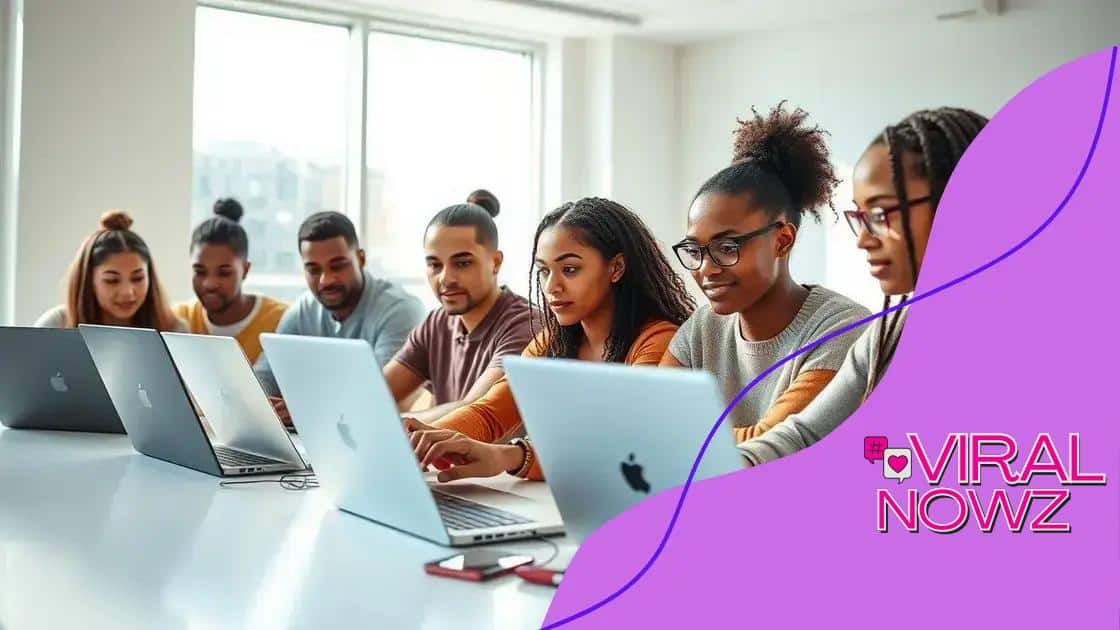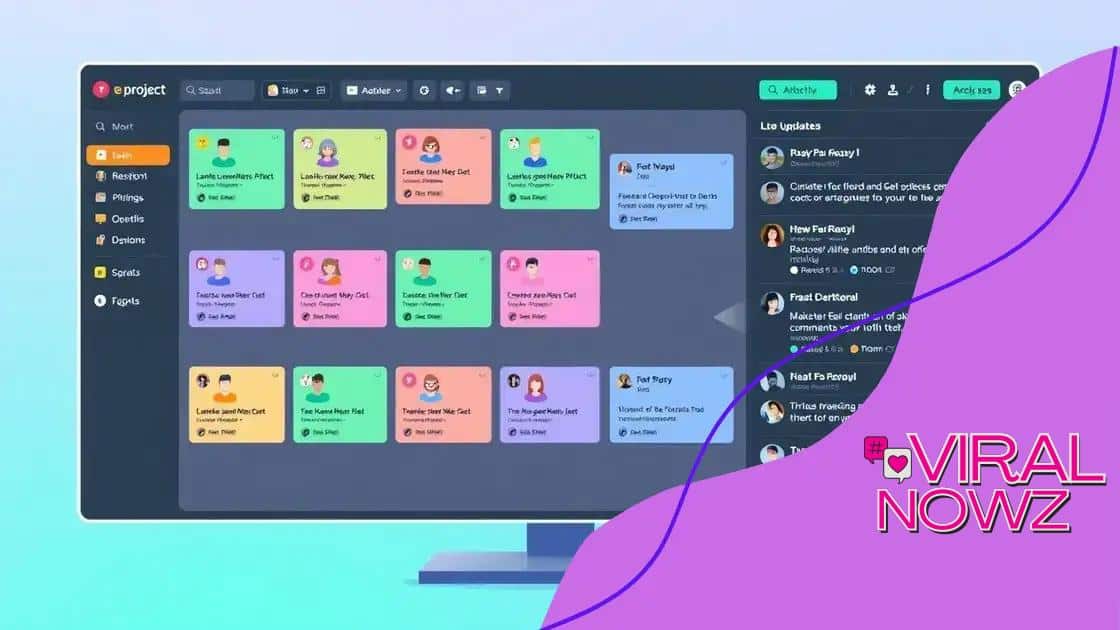Collaborative online learning environments for global education

Collaborative online learning environments for global education leverage technology, AI, and interactive tools to foster global connections, enhance cultural awareness, and promote lifelong learning among students.
Collaborative online learning environments for global education offer innovative ways for students from different backgrounds to connect and learn together. Have you ever wondered how these platforms transform educational experiences around the world?
The role of technology in collaborative learning
The role of technology in collaborative learning cannot be overstated. It has transformed how students and educators interact, making learning more accessible and engaging. By leveraging various tools and platforms, collaboration can cross geographical and cultural boundaries, opening doors for a global education experience.
Key Technologies in Collaborative Learning
There are several key technologies that facilitate effective collaboration among learners. These tools enhance communication and make it easier for students to work together on projects.
- Video conferencing tools help students connect face-to-face virtually.
- Collaboration software enables real-time editing of documents.
- Learning management systems centralize resources, assignments, and feedback.
- Social media platforms can also foster discussions and group work.
Additionally, the integration of technology in educational settings encourages students to take an active role in their learning journey. With tools like interactive simulations and online forums, students can engage deeply with the material and with each other. This shift fosters a sense of community that is essential for successful collaborative learning.
Benefits of Using Technology
The benefits of utilizing technology in collaborative learning environments are numerous. First and foremost, technology caters to diverse learning styles. Students can choose different ways to engage with content, whether through visual aids, interactive activities, or discussions.
Moreover, technology facilitates better time management for group projects, allowing students to coordinate their efforts more efficiently. They can set deadlines, assign tasks, and monitor progress easily. This level of organization leads to more productive collaborations.
Finally, technology prepares students for the workforce by equipping them with essential collaboration skills. Working together on platforms mirrors real-world scenarios where teamwork and communication are critical. This real-life application helps students become more competent in their future careers.
Benefits of global teamwork in education
The benefits of global teamwork in education are profound and impact both students and educators. Collaborating with peers from different countries cultivates a rich learning environment, exposing learners to diverse perspectives and cultures. This experience not only enhances academic knowledge but also promotes empathy and understanding.
Enhanced Cultural Awareness
Engaging in global teamwork fosters cultural awareness. As students collaborate, they learn about their peers’ backgrounds, traditions, and viewpoints. This can help break down stereotypes and build mutual respect.
- Students gain insights into different educational practices.
- They develop a deeper appreciation for global diversity.
- Exposure to varying communication styles improves interpersonal skills.
This cultural exchange enriches their educational experience and prepares them for a more connected world.
Improved Problem-Solving Skills
Working on international projects also enhances students’ problem-solving skills. When faced with challenges that require input from various team members, students learn to think critically and creatively. They discover unique approaches to complex problems and gain confidence in their ability to contribute.
This teamwork encourages innovation, as students brainstorm and share ideas. The combination of different perspectives leads to more effective solutions.
In addition, global teamwork helps students practice active listening. As they engage with remote teammates, they must pay attention to different viewpoints, which also strengthens their communication skills. These abilities are essential in both academia and future careers.
Access to Resources and Knowledge
Collaboration extends beyond cultural exchanges; it also provides access to a wealth of resources. Students often share valuable materials, articles, and research that broaden their understanding of a subject.
This collaborative approach to learning means that no student has to face challenges alone. They can tap into the knowledge pool of their peers, enhancing their overall learning experience. The combined expertise of a diverse group creates a richer educational landscape.
Effective tools for online collaboration

Utilizing effective tools for online collaboration enhances the learning experience for students across the globe. These tools enable seamless communication, project management, and resource sharing, making group work more efficient and engaging. With the right technology, students can collaborate in real-time, regardless of their physical locations.
Popular Collaboration Platforms
There are several platforms that stand out in supporting collaborative learning. These tools offer various features that cater to different needs.
- Platforms like Google Workspace allow users to create and edit documents simultaneously.
- Microsoft Teams integrates chat, video meetings, and file sharing into one interface.
- Trello helps teams organize tasks visually, allowing for clear project tracking.
- Slack enhances communication with channels for different topics and direct messaging features.
Each of these tools fosters teamwork by simplifying coordination and streamlining workflows for students.
Benefits of Using Collaboration Tools
Effective collaboration tools offer various benefits to students engaged in group projects. They improve accessibility, allowing students to join discussions and contribute regardless of where they are. This flexibility is vital in today’s learning environment, where remote work is common.
Moreover, these tools promote accountability. Team members can assign tasks and set deadlines, which helps everyone stay on track. This shared responsibility enhances the overall productivity of the group. Additionally, many platforms provide feedback loops where students can comment and suggest improvements, fostering a culture of constructive criticism.
Teaching students to use these tools effectively prepares them for future workplaces that rely on digital collaboration. Mastering online communication and project management is a critical skill that will serve them well in their careers.
Challenges in implementing collaborative environments
While there are many advantages to collaborative learning, several challenges in implementing collaborative environments can arise. These challenges can hinder the effectiveness of group learning experiences. Identifying and addressing these obstacles is crucial to create a productive collaborative atmosphere.
Technical Issues
One of the primary challenges is dealing with technical issues. Students may face connectivity problems, software bugs, or difficulty navigating unfamiliar platforms. These issues can disrupt the learning process and frustrate students.
- Inconsistent internet connections can hinder real-time collaboration.
- Students may require training to effectively use new tools.
- Compatibility problems among different software can arise.
Ensuring reliable technology access is essential for successful collaboration.
Communication Barriers
Another obstacle is communication barriers, which can affect teamwork. Misunderstandings may occur due to cultural differences or varying communication styles. Additionally, language barriers can make collaboration challenging, especially in diverse groups.
To overcome these barriers, fostering an open and inclusive environment is vital. Encouraging students to express themselves and ask questions can help mitigate misunderstandings. Regular check-ins and feedback sessions can enhance clarity.
Group Dynamics and Participation Issues
Group dynamics can also pose challenges. Some students may dominate conversations, while others may hesitate to share their ideas. This imbalance can lead to frustration and disengagement.
Facilitating equal participation is crucial. Teachers and facilitators can encourage quieter students to contribute by creating structured roles within the group. Setting ground rules for collaboration can promote respect and active involvement from all members.
Additionally, evaluating team participation is important, allowing for recognition of individual contributions. By addressing these dynamics, students can work together more effectively.
Future trends in online global education
The future trends in online global education promise to reshape how students learn and interact worldwide. As technology advances, new methods and concepts emerge to enhance collaborative learning. Institutions are beginning to explore innovative strategies to connect students beyond borders.
Increased Use of Artificial Intelligence
One major trend is the integration of artificial intelligence in education. AI tools can personalize learning experiences by adapting to each student’s needs. This means students can work at their own pace, receiving tailored feedback and resources.
- AI can analyze students’ performance to identify weaknesses.
- Chatbots may assist with answering questions quickly.
- Intelligent tutoring systems provide on-demand support.
This personalized approach can lead to better engagement and improved outcomes for learners.
Interactive and Immersive Learning Experiences
Additionally, interactive learning experiences are becoming increasingly popular. Augmented reality (AR) and virtual reality (VR) technologies provide immersive environments for students to explore. These tools not only make learning more engaging but also allow students to simulate real-life scenarios.
For instance, students can explore historical sites or conduct virtual experiments in a safe setting. This hands-on learning encourages exploration and creativity, enabling a deeper understanding of complex subjects.
Focus on Lifelong Learning
Another significant trend is the emphasis on lifelong learning. In today’s fast-paced world, the ability to continuously update skills is essential. Online platforms are adapting to meet the demands of adult learners who seek flexible options to advance their careers.
Many universities and organizations now offer micro-credentials and short courses that can quickly equip learners with new skills. This accessibility opens up opportunities for everyone, regardless of age or background.
By fostering a culture of lifelong learning, educational institutions can better prepare students for the ever-changing job market.
FAQ – Frequently Asked Questions about Online Global Education
What role does technology play in online global education?
Technology provides the tools for collaboration, communication, and resources, making learning more accessible and engaging for students around the world.
How can artificial intelligence enhance online learning experiences?
AI can personalize learning by adapting to individual needs, providing tailored resources, and supporting students with instant feedback.
What are some examples of immersive learning tools?
Augmented reality (AR) and virtual reality (VR) tools allow students to engage in interactive experiences that simulate real-world scenarios.
Why is lifelong learning important in today’s education landscape?
Lifelong learning ensures individuals can continuously update their skills, making them adaptable to changing job markets and new opportunities.





